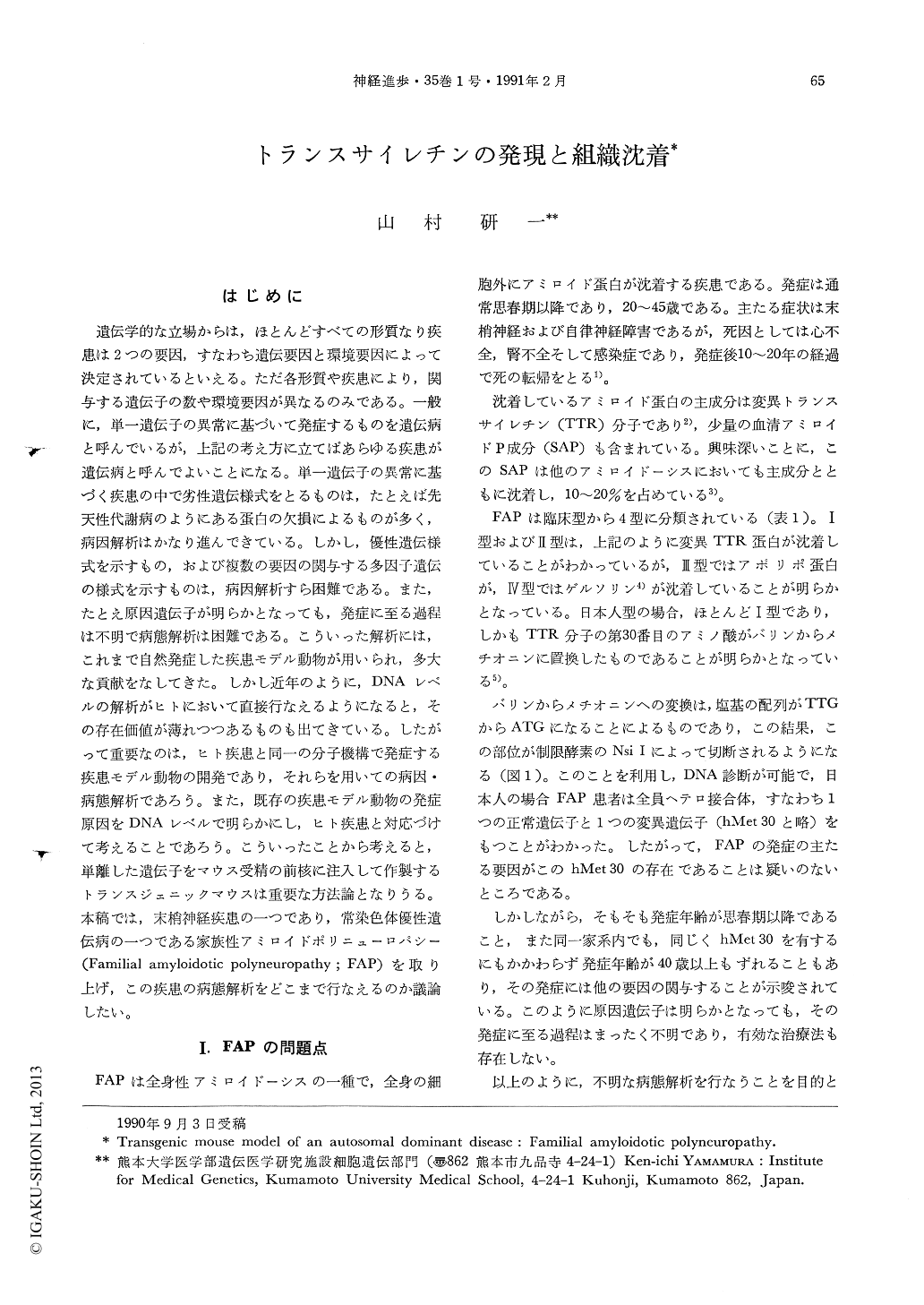Japanese
English
- 有料閲覧
- Abstract 文献概要
- 1ページ目 Look Inside
はじめに
遺伝学的な立場からは,ほとんどすべての形質なり疾息は2つの要因,すなわち遺伝要因と環境要因によって決定されているといえる。ただ各形質や疾患により,関与する遺伝子の数や環境要因が異なるのみである。一般に,単一遺伝子の異常に基づいて発症するものを遺伝病と呼んでいるが,上記の考え方に立てばあらゆる疾患が遺伝病と呼んでよいことになる。単一遺伝子の異常に基づく疾患の中で劣性遺伝様式をとるものは,たとえば先天性代謝病のようにある蛋白の欠損によるものが多く,病因解析はかなり進んできている。しかし,優性遺伝様式を示すもの,および複数の要因の関与する多因子遺伝の様式を示すものは,病因解析すら困難である。また,たとえ原因遺伝子が明らかとなっても,発症に至る過程は不明で病態解析は困難である。こういった解析には,これまで自然発症した疾患モデル動物が用いられ,多大な貢献をなしてきた。しかし近年のように,DNAレベルの解析がヒトにおいて直接行なえるようになると,その存在価値が薄れつつあるものも出てきている。したがって重要なのは,ヒト疾患と同一の分子機構で発症する疾患モデル動物の開発であり,それらを用いての病因・病態解析であろう。また,既存の疾患モデル動物の発症原因をDNAレベルで明らかにし,ヒト疾患と対応づけて考えることであろう。こういったことから考えると,単離した遺伝子をマウス受精の前核に注入して作製するトランスジェニックマウスは重要な方法論となりうる。本稿では,末梢神経疾患の一つであり,常染色体優性遺伝病の一つである家族性アミロイドポリニューロパシー(Familial amyloidotic polyneuropathy;FAP)を取り上げ,この疾患の病態解析をどこまで行なえるのか議論したい。
Familial amyloidotic polyneuropathy (FAP) is an autosomal dominant disorder characterized by the extracellular deposition of amyloid fibrils and by prominent peripheral nerve involvement. The first symptoms usually appear in individuals between 20 and 45 years of age, and the disease is always progressive and fatal in about 10 to 20 years. The amyloid protein is mainly composed of transthyretin (TTR; a protein formerly known as prealbumin) with a substitution of methionine for valine at position 30 in the FAP type I, as reported in Japan, Sweden, and Portugal. These amyloid deposits also contain a small but significant amount of serum amyloid P component (SAP). Several other different amino acid substitutions have been identified in different areas. These amino acid substitutions are thought to lead to amyloid deposition. The human TTR gene has been cloned and well characterized at molecular level. Using this gene it is now possible to carry out a DNA diagnosis of FAP. All the Japanese FAP patients so far examined are heterozygotes, carrying one normal and mutant gene. Thus, it is clear that the main cause of this disease is the presence of a mutant TTR gene. However, in patients with FAP, the age at onset varies from 20s to 45 years. In addition the clinical syndrome is variable even among kindreds with the same genetic defect. These data suggest involvement of factor(s) other than the single nucleotide mutation in the TTR gene. Furthermore, there is no specific therapy for FAP. To elucidate the pathological process of this disease development and to devise a new method for treatment, we have attempted to produce a transgenic mouse model of FAP.

Copyright © 1991, Igaku-Shoin Ltd. All rights reserved.


